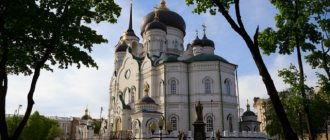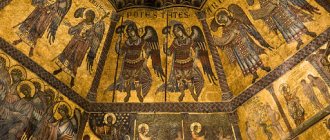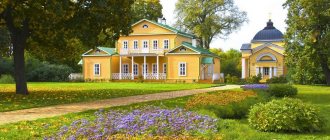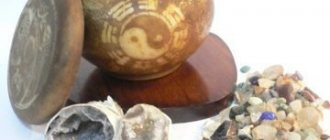The meaning of the word Throne according to Ushakov’s dictionary:
THRONE , throne, m. 1. The throne of the monarch (mainly as a symbol of his power). Tsar Saltan sits in the chamber, on the throne and wearing a crown. Pushkin. Ascend to the throne (become a monarch). To dethrone (to deprive a monarch of power). Heir to the throne (the person to whom the power of the monarch passes by inheritance). throne is shaking. A.K. Tolstoy (i.e. power fluctuates). Abandoned by his troops, the king had to surrender: he signed an abdication of the throne both for himself and for his son. Lenin. 2. In the church - a table in the altar, opposite the so-called. royal doors (church).
Evolution of the throne
Photo: Kamensk-eparhiya.ru
In early Christianity, thrones were portable, and wood or stone were used to make them. Their location in the church was confirmed in the 4th century. Since then, they have primarily been made from stones. Outwardly, they look like low tables with four legs, which were placed inside the altar, where ordinary believers are prohibited from entering.
Over time, to replace the standard four legs, the throne began to be made on one; another alternative option was to make a solid stone base. Since the beginning of the 10th century, a tradition that has become established over time has emerged to place the altar directly in the very center of the altar.
From the 15th century, thrones began to be made of wood or made in the form of impressive stone monoliths. They had a lid at the top; it had to be covered with a special cloth.
The meaning of the word Throne according to the Brockhaus and Efron dictionary:
The altar is the main accessory of the altar of a Christian church. In the Orthodox Church, this is a four-sided table standing in the middle of the altar and serving as the place where the Eucharist is celebrated. Church rules require that it be on four pillars, arshins and six vershoks in height. the width and length can be different, depending on the extent of the altar. He is put on two clothes: the lower one, or srachitsa (κατασάρκα.), depicting the shroud with which the body of I. Christ was entwined during burial, and the upper one, inditia (ενδιτη.), mostly light, the same in material and color as the priest’s robe. During the consecration of the temple, P. is girded around his lower garment with a rope as a reminder of the bonds of I. Christ (John, XVIII, 24). During the bishop's consecration of the temple, P. is tied with a rope so that on each side of it a cross is depicted with a rope. The upper robe of P. is sometimes, due to the zeal of parishioners or at the temple’s own expense, made of silver, with chased images of sacred persons and events. In a mysterious sense, P. depicts the heavenly place of the settlement of the Lord Pantocrator, as well as the tomb of Christ, since the body of Christ reclines on it. therefore, no one except clergy is allowed to touch P. It is forbidden for persons of non-holy rank to pass between P. and the royal gates, as well as between P. and the mountain place. The peculiarity of P. in Catholic churches is that it is placed close to the wall. N. B—v.
Symbolism
Photo: Sobory.ru
The throne plays a big role in Orthodoxy. It is believed that this is the place of the mysterious and invisible location of the Savior. For this reason, only priests are allowed to stand in front of him, much less touch him.
Several symbols associated with them in the Orthodox tradition should be noted:
- The throne has four sides, which represent the cardinal directions. In addition, the four sides of the throne symbolize parts of the day, seasons and tetramorphs (these are creatures known from the described visions of John the Evangelist).
- The 4-cornered shape of the throne represents the four Gospels.
- Finally, it is a symbol of the Holy Sepulcher.
If a ciborium (canopy) is placed directly above it, personifying the sky, then the throne itself becomes a symbol of the earth where the Savior descended to atone for the sins of mankind. Usually on the ciborium there is an image of a dove, representing the Holy Spirit.
vestment
/omolitvah.ru/wp-content/uploads/2020/06/foto-3-prestol-pravoslavie.ru_-300×198.jpg" target="_blank">https://omolitvah.ru/wp-content/uploads /2020/06/fo...ol-pravoslavie.ru_-300×198.jpg 300w" /> Photo: Pravoslavie.ru
The vestment of the throne in the Orthodox Church is a cover made of brocade, which is put on top. In most cases, its color coincides with the symbolic color of the church holiday, but this is not at all necessary.
In some cases, the vestments are made of gold or metal. In this case, it is a case covered with precious stones and gold jewelry.
One of the most famous altars is in the Cathedral of St. Sofia. This is a case made of pure gold, decorated with precious stones.
Story
As mentioned earlier, in the church the throne is a special table for celebrating the Eucharist. In ancient times, such tables were portable and small in size. They were made of stone or wood. Starting from the 4th century, when their location in the temple was finally determined, they became more massive and were created exclusively from stone.
They began to be installed in front of the altar in the apse on four legs. Later, instead of four, they began to have one or no legs at all, and they were replaced with a special stone base. From the 10th century, altars began to be installed inside the altar apse, moving them inward from the center.
The Holy See
This is the collective official name of the main administrative body of the Vatican (Roman Curia), as well as the name of the Pope himself. It is sovereign and has its own territory - the Vatican City, which is a city-state.
That is, the term “Holy See” can be understood as both the Vatican itself and the Pope. This is a polysemantic term that is both specific and general. It all depends on the context in which it is used.
As a city-state, it has had its independence from Italy for more than 14 centuries. It was established by Pope Gregory the Great in 601; moreover, this independence is the oldest in the world.
The Holy See is an elected theocratic monarchy headed by the Pope. The latter is elected by the College of Cardinals (conclave) for life. This is where the expression “accession to the throne” came from. This means becoming a monarch. In this case, lead the Vatican.
The Pope is the supreme ruler of the Catholic Church throughout the world, the chief hierarch and sovereign of the Vatican. These functions are inseparable. The Government of the Holy See is a special administration in the Vatican (Roman Curia), which is divided into two departments - general and foreign affairs. These, in turn, are segmented into congregations and commissions.
Now, having encountered a studied term in life, one can confidently judge what it means in a given situation.
Story
In ancient times, thrones were made of wood or stone and were portable. From the 4th century, when their place in the temple was finally determined, the altars began to be made of stone in the form of a low table on four legs in front of the altar apse. Subsequently, instead of four, thrones began to be installed either on one leg or on a stone base. In the 19th century, the altars are located in the depths of the altar apse.
Throne in the altar of the Church of the Savior on Spilled Blood.
Starting from the 15th-16th centuries, thrones are made either in the form of stone monoliths or of wood, in the form of a frame with a lid on top, which is covered on the outside with a cloth vestment. The vestment is a cover made of expensive brocade fabric, worn on the throne. Very often, but not necessarily, the color of the vestments of the throne corresponds to the liturgical color of the church holiday. The vestments can be made not only of fabric, such as brocade, but also of a metal, even gold, case for the throne, richly decorated with gold and stones. The throne of the Church of Hagia Sophia in Constantinople was made of gold and precious stones.
Already in the early Church there was a tradition of placing relics under altars. Since the 8th century (7th Rule of the Seventh Ecumenical Council), the investment of relics has become a mandatory part of the rite of consecration of the temple. The relics were placed either at the base of the throne or in a special hole under the throne.
Symbolic meaning
It is a place of the mysterious presence of Jesus Christ. Only clergy are allowed to stand in front of the throne, as well as touch it.
The throne has the following symbolic meaning:
- four sides: cardinal directions, seasons, periods of the day, tetramorph (creatures from the vision of John the Evangelist);
- quadrangular shape: Four Gospels;
- Holy Sepulcher.
If a canopy (ciborium) is installed above the throne, then it symbolizes heaven, and the throne itself symbolizes the earth on which Jesus Christ suffered. Often in the center of the ciborium above the throne a figurine of a dove is placed, symbolizing the descent of the Holy Spirit.









